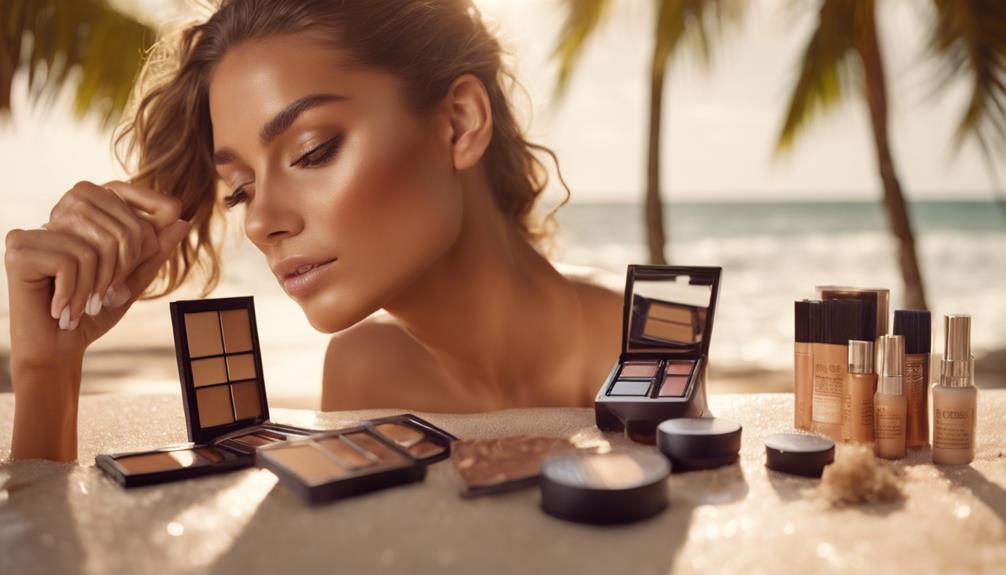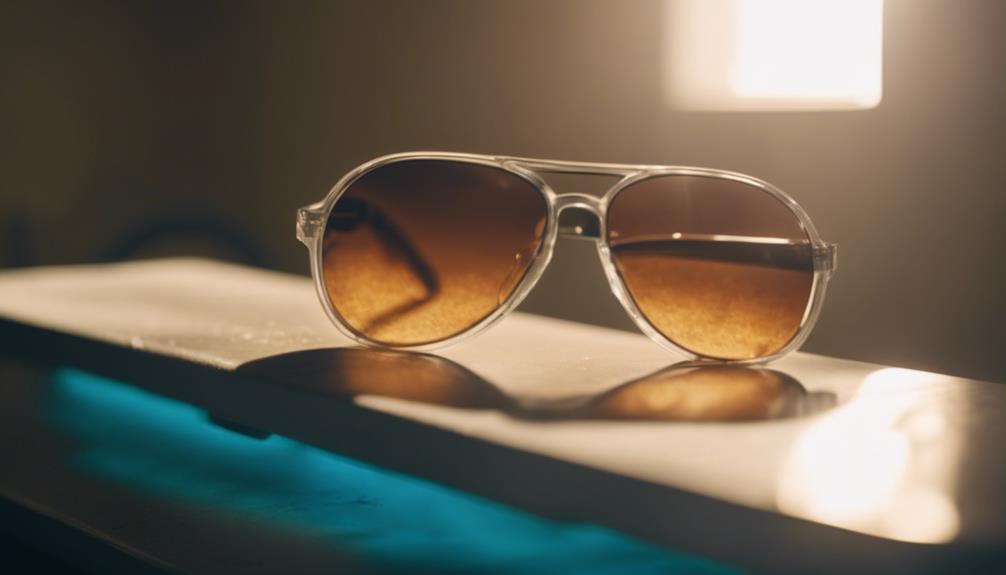Exploring the mysteries of tanning bronzers can help you achieve that fabulous, sun-kissed appearance without harming your skin! You have various options such as instant bronzers for a quick tan or gradual ones that develop over time. Applying them is simple; just ensure your skin is clean and use a tanning mitt to prevent orange palms – yikes! Remember to moisturize to prolong your tan. It’s like choosing between a fast bike ride or a leisurely walk – both enjoyable, but you need to pick what works best for you! Stay tuned for more tips on achieving that killer glow!
Key Takeaways
- Tanning bronzers use dihydroxyacetone (DHA) for color development, offering a sun-kissed glow without UV exposure risks.
- There are different types of bronzers: natural, chemical, instant, and gradual, each with varying results and longevity.
- Proper application techniques, such as using a mitt and circular motions, ensure even color distribution and prevent staining hands.
- Maintaining hydration and using moisturizers post-application can enhance and prolong the vibrancy of your tan.
Understanding Tanning Bronzers
Tanning bronzers let you achieve a sun-kissed glow without the risks of sun exposure. Imagine walking into a room and turning heads with your radiant skin!
These bronzers contain an ingredient called dihydroxyacetone, or DHA for short. It works by reacting with the top layer of your skin, creating that golden color you crave. Isn't that cool?
You can choose between instant bronzers for a quick boost or gradual ones that build up your tan over a few days. Plus, you don't have to worry about harmful UV rays, which is a major win!
Types of Tanning Bronzers

There are several types of bronzers available, each designed to suit different tanning preferences and needs.
First up, you've got natural bronzers, which give you that instant glow but wash away in about four days—perfect for a quick boost!
Then, there are chemical bronzers, packed with DHA that develop gradually for a long-lasting tan, sometimes sticking around for up to ten days.
If you want to see results right away, instant bronzers are your go-to, while gradual bronzers let you build color over time.
Just remember, the DHA concentration matters too; higher percentages mean deeper tans!
How to Apply Bronzers

Before applying bronzers, make sure your skin is clean and exfoliated for the best results.
Think of exfoliating like polishing a car; you want a smooth surface for that shiny finish!
Grab a tanning mitt to avoid staining your hands—trust me, no one wants orange palms.
Start with a small amount of bronzer, applying it in circular motions to blend evenly.
Don't forget those tricky spots like elbows and knees; they can absorb more color, making them look like they're ready for a dance-off!
Allow the bronzer to dry before getting dressed, so you don't accidentally leave a bronzed trail on your favorite shirt.
With a little practice, you'll be a bronzing pro in no time!
Safety Precautions

Ensuring your skin's safety is essential when using bronzers, so always perform a patch test to check for any allergic reactions before applying it fully. You wouldn't want to find out the hard way, right?
Keeping your skin healthy is vital, and here are some precautions to remember:
- Always check DHA levels to suit your skin type.
- Be cautious with tingle products; they can cause discomfort.
- Rinse off bronzer after use, especially from your face.
- Use bronzers with hydration benefits to keep your skin smooth.
Maintaining Your Tan

To maintain your tan, keep your skin hydrated and moisturized daily to prolong its vibrancy. Think of your skin like a plant; if you don't water it, it'll wilt!
Use a good moisturizer after showering; this can help lock in that glorious glow. Additionally, try to avoid long, hot showers, as they can strip your tan away faster than you can say “bronzer.” Instead, opt for lukewarm water, and keep your showers short.
And don't forget sunscreen! Even if you're already tanned, protecting your skin from sun damage is super important.
Comparing Bronzers and Tanners

Maintaining your tan highlights the importance of understanding the differences between bronzers and sunless tanners, as each serves a unique purpose in achieving your desired glow.
You'll find that bronzers give you instant color, perfect for those last-minute plans, while sunless tanners develop gradually, giving you a more natural look over time.
Here's a quick comparison to help you decide:
- Instant vs. Gradual: Bronzers provide immediate color; tanners take time to develop.
- Chemical Reaction: Bronzers react with your skin for long-lasting color; tanners vary in effectiveness.
- No Mess: Natural bronzers leave no stains after use.
- Skin Benefits: Many bronzers condition your skin as they color.
Tips for Choosing Bronzers

When choosing a bronzer, consider your skin type and the desired depth of color to find the perfect match for your tanning goals.
If you've got fair skin, a lighter bronzer might be your best pal, while deeper skin tones can rock those richer hues.
Think about how long you want your tan to last; instant bronzers give you that quick glow, while gradual options build up over time—like a delicious layer cake!
Don't forget to check the DHA levels; too much can lead to a streaky disaster.
And hey, always do a patch test first. It's better to be safe than sorry, right?
Frequently Asked Questions
Can I Use Bronzers on My Face and Body?
Yes, you can use bronzers on both your face and body. Just choose the right formula for each area, ensuring it suits your skin type, and apply carefully for an even, natural-looking glow.
How Do I Remove a Bronzer if I Mess Up?
Imagine a canvas marred by an unintended splash of paint. If you mess up a bronzer application, gently exfoliate the area with a scrub or use a makeup remover to restore your skin's natural tone.
Are Bronzers Suitable for All Skin Types?
Bronzers can suit various skin types, but not all. You should consider your skin's undertones and sensitivity. Testing different products helps you find the perfect match for your unique complexion and desired results.
Can Bronzers Cause Skin Irritation or Breakouts?
If you've ever experienced redness after using a bronzer, you know they can cause irritation. Always patch test first. Some ingredients might not suit your skin, potentially leading to breakouts or discomfort. Stay informed!
How Often Should I Reapply Bronzer for Best Results?
You should reapply bronzer every 4 to 7 days for ideal results, depending on the product type and your skin's natural exfoliation. Regular touch-ups guarantee a consistent, sun-kissed glow without looking patchy or faded.
What are the Benefits of Using Tanning Bronzers for Tanning Success?
Tanning bronzers offer secrets to tanning success by providing natural-looking color without the harmful effects of UV rays. They also help even out skin tone, reduce the appearance of imperfections, and prolong the life of your tan. With a tanning bronzer, you can achieve a beautiful, sun-kissed glow all year round.
Conclusion
Now that you've uncovered the secrets of tanning bronzers, you're ready to shine!
Did you know that about 75% of people prefer a sun-kissed look without the sun's harmful rays? That's a lot of glowing fans!
So, whether you're going for a quick glow or a subtle tan, make sure to pick the right bronzer for you.
Have fun experimenting, and remember, practice makes perfect.
Soon, you'll be rocking that radiant complexion with confidence!









